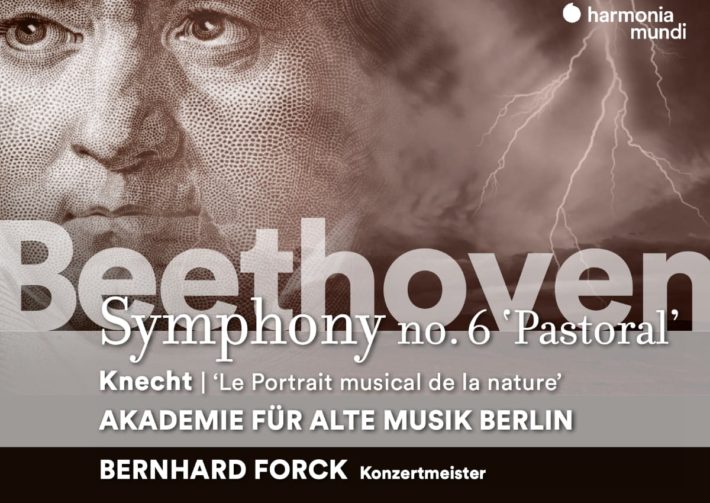This new recording of Beethoven’s Pastoral is paired with a little known but fascinating work by Justin Heinrich Knecht, “Le portrait musical de la nature.” Completed in 1785, almost 25 years before Beethoven’s nature symphony, this is only the third recording of the work.

Born in Biberach in 1752, Knecht was the son of a church musician. After early studies with his father, he traveled to Esslingen for further study, and then returned to Biberach to teach and direct at the local Lutheran church and its school. Apart from a brief stint at the Stuttgart court in the early 1800s, Biberach was his musical home until his death in 1817. His output includes sacred choral works, as well as music for keyboard, chamber music, operas, Singspiels and incidental music. During his lifetime, Knecht was best known for his manuals on harmony and organ playing. Hearing this new recording of “Le Portrait musical de la Nature ou Grande Simphonie” reveals a composer of considerable gifts.
Like the Pastoral, Knecht’s symphony has five movements and a descriptive title precedes each movement. The first movement is introduced with: “A beautiful landscape where the sun shines, the gentle zephyrs flutter, the streams flow across the valley, the birds’ chirp, a mountain brook trickles babbling from above, the shepherd blows his pipe, the sheep gambol and the shepherdess sings in her sweet voice.” And that is indeed what Knecht captures, flute trills evoking the bird song and flowing sixteenth-note runs portraying the flowing stream. Just as in the Beethoven, there is a storm, which is spread across three of the movements: the sky darkens and becomes threatening in movement 2, and the thunder and lightning storm duly erupts in the third movement. The fourth movement paints the storm subsiding, leading into the final movement where “Nature, transported by joy, raises its voice to heaven and renders fervent thanks to the Creator in sweet and pleasant songs.”
While there is no direct evidence Beethoven knew Knecht’s piece, it is highly likely. Both composers had works published by the same publisher, and Knecht’s organ method was found in Beethoven’s estate. And the two quotes above clearly demonstrate the similarities between the descriptive titles used in both symphonies. Nevertheless, hearing both works in the same program is inevitably unfair to Knecht, who comes across as a thoroughly competent composer, capable of pretty melodies and engaging orchestration. The Akademie of Ancient Music Berlin clearly enjoys the work, playing with vigor and attention to detail that present the work in the best possible light. Played on original instruments, with a more detailed sound picture, the work sounds far more impressive than in the Naxos recording featuring the Torino Philharmonic Orchestra led by Christian Benda.
The opportunity to hear Beethoven’s symphony immediately after the Knecht had me thinking again of Beethoven’s description of his sixth as “more the expression of feeling than painting.” Perhaps this was a subtle critique of Knecht’s efforts? As I listened to the Beethoven, the difference in intent was never clearer: Knecht was content to paint aural pictures, whereas Beethoven wants us to know and experience his feelings amid nature. The juxtaposition provides the listener with a new way to admire what Beethoven accomplished.
As to performance itself, it is unique in being led by the concertmaster instead of a conductor. The playing is ravishingly beautiful, and I was particularly touched by rapt introspection the orchestra finds in the second movement. Tempi for the third and fourth movements are significantly slower than Beethoven’s metronome markings, and this makes the country dance more elegant, less rustic than in Norrington and Gardiner versions. And the thunderstorm is certainly less destructive. But there is ample compensation in a performance that, using a smaller than usual string section, allows greater clarity to the inner voices, and the slower tempi really gives the winds a chance to shine: listen to the playful give and take between oboe, bassoon and clarinet in the Scherzo (track 8, 0’55”). While the storm is not as fiercely powerful as Gardiner’s, it still threatens (and the lower strings playing is particularly fabulous).
There are sure to be dozens of new and re-released recordings of Beethoven’s symphonies this anniversary year; Harmonia Mundi plans this to be the first volume of another full cycle played by this ensemble (Symphonies 1,2,4 and 8), Les Siècles, and François-Xavier Roth (3 and 8) and the Freiburger Barockorchester (the Seventh conducted by concertmaster Gottfried von der Goltz, the Ninth with conductor Pablo Heras-Casado). some might say we are already overly saturated. But this new performance of the Beethoven will certainly reward repeated hearing, and there is much to appreciate in Knecht’s symphony as well. This unusual pairing may well make the recording more enticing. Harmonia Mundi’s recording is warm, rich and natural, and comes with a brief but informative liner notes and first-class packaging – warmly recommended.
Beethoven – Symphony No. 6, Op. 68 (“Pastoral”)
Knecht – Le Portrait Musical De La Nature Ou Grande Simphonie
Akademie für Alte Musik Berlin
Bernhard Forck – Concertmaster
Harmonia Mundi, CD HMM 902425




















